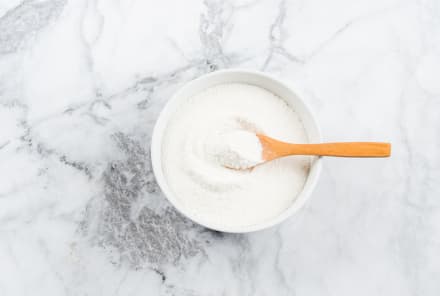Advertisement
The Pitta Dosha: How To Eat, Exercise & De-Stress To Keep It In Check


Ayurveda is an ancient healing science that sets out to create a balance between the mind, body, and spirit. That balance comes when the three doshas—vata, pitta, and kapha—exist in harmony. Each dosha corresponds to different thought patterns, body types, and health profiles. Most of us are dominant in one or two of the doshas. (Not sure which dosha you are? This dosha quiz will help you find out.) Here's everything you need to know about the qualities and characteristics of the fiery pitta dosha and how to keep it in balance using food, movement, and lifestyle shifts.
Pitta qualities and characteristics.
The pitta dosha translates to "that which digests things." Pitta's role is transformation: In addition to moving along the digestive system, it also corresponds to metabolism and hormones.
It's associated with fire and heat, and those who are pitta-dominant are often sharp-witted, competitive, and highly focused. They are intelligent and outspoken, making them good leaders, speakers, and teachers. They tend to be linear, straightforward thinkers who are goal-oriented. Physically, they have angular features, bright eyes, and moderate body weight. Those who have too much pitta may be prone to issues like acne, skin rashes, heartburn, and indigestion.
Signs of a pitta imbalance.
"Pitta imbalances involve too much heat in the tissues," says Marie Harger, an ayurvedic health practitioner. That can cause rashes, infections, headaches, migraines, smelly body odors and eliminations, and digestive issues like frequent hunger and diarrhea.
Pitta imbalances can also present emotionally: Being overcritical of yourself and others, overthinking and overanalyzing situations, feeling restless, and having a short temper are all indicators of a potential pitta imbalance.
How to balance pitta.
In general, if you have too much intense, fiery pitta in your system, it's a good idea to balance it out with cooling foods and activities. "Spontaneity and relaxation are great aspects to bring into a pitta's life to help balance their intensity and drive," explains Milla Stanton, an ayurvedic health educator.
Don't overschedule yourself, and take care to build rest into your schedule. Make a point to spend time in nature and keep fresh flowers and plants in your home and at work. Surround yourself with soothing colors and opt for sweet, cooling fragrances like rose, mint, jasmine, and chamomile. A daily massage can also be helpful for calming elevated pitta.
Eating and drinking for pitta.
"Pitta needs to eat foods that are cooling to the tissues," says Harger. Pay attention to foods that seem to aggravate symptoms of pitta (causing burning sensations, heartburn, or diarrhea), and see what happens when you swap in a few cooling ingredients. (Ginger can make things worse.)
Keep your digestive system humming with three square meals a day, minimal snacking, and a consistent eating schedule. And whenever possible, minimize distractions while you eat. "Processed foods and leftovers are thought to lack vital energy and can have ingredients that aggravate all doshas, so they are to be avoided," says Stanton.
Eating for your dosha can go a long way toward keeping you feeling great, but keep in mind that this kind of intentional eating is more a practice and less a list of hard-and-fast rules. Here is an overview of the Ayurvedic diet. Be sure to talk to your physician before drastically changing your diet or starting a new supplement routine.
What to eat:
- Foods with sweet, bitter, astringent tastes
- Milk, butter, and ghee in moderation
- Wheat, basmati rice, oats, and barley
- Sweet fruits like mangoes, melons, grapes, plums, and pomegranates
- Vegetables like sweet potatoes, leafy greens, broccoli, cauliflower, green beans, and zucchini
- Chicken and turkey
- Mild spices, especially fennel, cumin, and coriander
What to avoid:
- Sour fermented dairy products, like yogurt and hard cheeses
- Brown rice, millet, rye, and corn
- Sour fruits like berries, grapefruit, and apricot
- Vegetables like hot peppers, beets, raw onions, garlic, spinach, and carrots
- Hot seasonings like cayenne and chili powders
- Alcohol, refined sugar, and caffeine
Best exercises for pitta.
Pittas tend to be naturally athletic and are often drawn to intense exercises that make them feel the burn. "They have a tendency to love competition and will burn themselves out by over-exercising and getting too intense," says Harger. Calmer, more relaxed workouts offer an important balance. Try something slow and purposeful, like yin yoga. Swimming can also be good for giving you space to stretch and strengthen your body without overheating.
Follow any intense training with a lengthy cool-down, stretch, and meditation. To avoid getting overheated, plan your workouts for cooler parts of the day. And schedule in those rest days! Focused, driven pittas tend to overlook them, but they'll benefit from the downtime.
The bottom line on finding balance.
Pitta imbalances, like any dosha imbalance, are often related to daily habits—what we eat, how we sleep, and what kinds of physical and mental stressors we endure. Understanding the nature of the intense and fiery pitta dosha makes it easier to find steps you can take to cool and calm yourself and restore harmony to all areas of your life.
Watch Next
Enjoy some of our favorite clips from classes
Enjoy some of our favorite clips from classes
What Is Meditation?
Mindfulness/Spirituality | Light Watkins
Box Breathing
Mindfulness/Spirituality | Gwen Dittmar
What Breathwork Can Address
Mindfulness/Spirituality | Gwen Dittmar
The 8 Limbs of Yoga - What is Asana?
Yoga | Caley Alyssa
Two Standing Postures to Open Up Tight Hips
Yoga | Caley Alyssa
How Plants Can Optimize Athletic Performance
Nutrition | Rich Roll
What to Eat Before a Workout
Nutrition | Rich Roll
How Ayurveda Helps Us Navigate Modern Life
Nutrition | Sahara Rose
Messages About Love & Relationships
Love & Relationships | Esther Perel
Love Languages
Love & Relationships | Esther Perel
What Is Meditation?
Box Breathing
What Breathwork Can Address
The 8 Limbs of Yoga - What is Asana?
Two Standing Postures to Open Up Tight Hips
How Plants Can Optimize Athletic Performance
What to Eat Before a Workout
How Ayurveda Helps Us Navigate Modern Life
Messages About Love & Relationships
Love Languages
Advertisement

This Little-Known Supplement Helps Women Sleep & Decreases Signs Of Depression
Molly Knudsen, M.S., RDN

Want To Be Metabolically Healthy? New Study Shows An Underutilized Approach
Molly Knudsen, M.S., RDN

This Little-Known Supplement Helps Women Sleep & Decreases Signs Of Depression
Molly Knudsen, M.S., RDN

Want To Be Metabolically Healthy? New Study Shows An Underutilized Approach
Molly Knudsen, M.S., RDN














